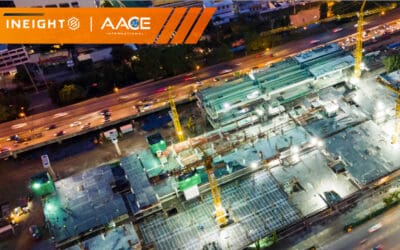The State of Victoria in southeastern Australia is investing heavily in public infrastructure through its Big Build program. To ensure the best outcomes and most efficient use of taxpayer money, the state aims to maximise the standardisation of processes and streamline information sharing between project offices.
Through a major digital transformation initiative called the Connect Program, the state has aligned processes and technologies across its Major Transport Infrastructure Authority (MTIA) and established centres of practice for all core project controls.
InEight spoke with MTIA to learn about this challenging initiative and how the organisation tackled it.
BENEFITS
- Enabling cross-department benchmarking through data consistency
- Streamlining and standardising processes for improved collaboration
- Boosting efficiency and quality by automating low-value tasks
If you prefer, download the full story here.
TAKING A CONNECTED APPROACH TO INFRASTRUCTURE MEGAPROJECTS
The Victorian Government’s Big Build program encompasses several infrastructure megaprojects, including the North East Link Project (NELP): the largest-ever investment in the northeast of the state capital Melbourne, which is home to almost five million people. Launched in 2022 with the aim of reducing road congestion, NELP will see the construction of freeway tunnels that will take 15,000 trucks off local roads every day and reduce travel times by up to 35 minutes.
A Director of Project Controls of NELP says: “Back in 2019, when we were setting up NELP, we consulted with the other project offices within the MTIA and found that they were using multiple different sets of processes and technologies. As a group, we asked, ‘How much better would things be if we could ensure greater synergy between us?’”
The director observes that there are often fundamental disconnects between the strategic governance of an organisation on the one hand, and the tactical project controls on the other. “Technology is often wrongly seen as a silver bullet here,” he says. “Rather than diving into a selection process, we thought about what we wanted to accomplish around project controls and data. Every project generates data, and it’s vital to consider how you’re gathering that data and what the intended purpose is. Before getting anywhere near the technology, we wanted to work out how we would transform data into relevant information, analyse it, and disseminate it.”
These discussions gave rise to the Connect Program, in which five major project offices within the MTIA joined forces for a AU$110 billion digital transformation initiative. Working with consultants from EY, the joint team successfully agreed on standardised project controls, establishing centres of practices for all the core elements such as cost, time, risk, quality, document control, information, collaboration, management and so on.
“We’ve managed to align the processes around project controls across the MTIA and consolidate our information, which means that we can report in a consistent way to the Office of the Director General, opening up the prospect of more accurate benchmarking,” says the director. “We also did a lot of market analysis and short-listed three technology vendors that we thought could support our requirements. Ultimately, we hope to have a single end-to-end technology platform, but we’re still on journey to rationalise the systems.”
STANDARDISING PROCESSES AND TECHNOLOGIES
When working with internal departments and external contractors, NELP writes specific requirements into contracts but does not mandate the use of any particular technology to complete the work. However, the organisation does require suppliers to work through its preferred collaboration platform — InEight Document — when submitting tenders and providing updates during the project delivery phases.
“Naturally, our internal and external partners will use different solutions than us to run their businesses— and that’s to be expected,” says the director. “But when they communicate with us, we ask them to do so in InEight Document. We do this because our legislative requirements mean we need to adhere to rigorous approaches in how we structure work and break down the time and costs.”
Through standardised communication on a single technology platform, NELP and the other MTIA project offices can collaborate more efficiently and benchmark their work more easily.
“If you don’t standardise either process or technology, you can end up comparing apples and oranges,” says the director. “Once you standardise, you improve the quality and control of data. That opens up the possibility of accurate benchmarking, which is something that government really looks for in terms of informing future business cases and decisions.”
DELIVERING THE RIGHT DATA TO THE RIGHT PEOPLE AT THE RIGHT TIME
On the question of data, MTIA pursues a less-is-more policy. While recognising that the industry is capturing, storing and analysing more and more data, it is keen to flip the picture. “I’m a big fan of keeping it simple: decide on the outcome you want and set up your processes and technology to deliver it. Otherwise, you may just end up with information overload,” he says.
Similarly, while real-time reporting is beginning to appear in the civil infrastructure industry, MTIA feels that it can create more problems than it solves. “Rapid, real-time reporting often results in people having access to information at a time that may not be appropriate, leading to a disconnect between management perceptions and what’s happening on the ground. It’s crucial to get through the month first, reflect, and only then tell the story behind your data. I believe there would be more value in thinking about how we present the data. We’re generating huge numbers of dashboards, but it’s not always clear that these are genuinely informative or helpful to decision-makers.”
ACHIEVING MORE WITH THE SAME RESOURCES
Many industries are currently struggling to attract and retain sufficient skilled employees, and this is certainly the case in civil engineering and construction. As the industry faces up to human resources shortages in key roles such as planners, schedulers, estimators, and cost engineers, it needs technology providers to boost the automation of repetitive, lower-value tasks, so that the existing skilled workforce can enjoy increased productivity and job satisfaction. “A lot of projects remain very manual, even in major tier-one organisations,” says the director. “Civil infrastructure lags behind pretty much every other industry in terms of digitisation; we need vendors to help us increase productivity and allow our people to work on higher-value tasks.”
He concludes: “Digital transformation isn’t easy. For us, the key to success has been getting executive input and support from the outset. Start with the senior executives and have a good business plan in place: the what, the why and the how. With a well-thought-out business plan, you’ll find it much easier to get key stakeholders on board and maximise the benefits of embracing digital ways of working.”
Learn what InEight Can do for your business.
ABOUT INEIGHT
InEight provides field-tested project management software for the owners, contractors, engineers and architects who are building the world around us. Over 300,000 users and more than 750 customers worldwide rely on InEight for real-time insights that help manage risk and keep projects on schedule and under budget across the entire life cycle. From pre-planning to design, from estimating to scheduling, and from field execution to turnover, InEight has powered more than $400 billion in projects globally across infrastructure, public sector, energy and power, oil, gas and chemical, mining, and commercial.
For more information, follow InEight on LinkedIn.



